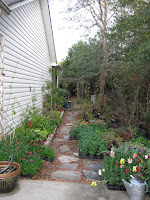Yesterday it was
my birthday,
I hung one more
year on the line;
I should be
depressed, my yard’s a mess,
But I’m havin’ a
good time.
I’m digging and
weeding and planting,
I’m exhausted from
gard’ning so well;
I should go to bed
but a voice in my head
Says, “Oh, what
the hell.”
with apologies
to Paul Simon

I have conducted a life-long love affair with Paul Simon’s
music. His lyrics have spoken to me since the 1960s, when I knew all the words
to all the songs from “Bookends,” “The Sounds of Silence,” “Parsley, Sage,
Rosemary and Thyme,” and “Bridge Over Troubled Water.” (Still do.) I
convinced my teenaged self that I was the Kathy on the bus from Pittsburgh in
“America,”
sans cigarettes. A
term paper entitled “Themes of Alienation and Loss in the Songs of Simon and
Garfunkel” turned in when I was a junior in high school brought me my first
important accolades as a writer: so impressed was the English teacher that she
made it required reading for her senior classes.
Fortunately,
I had no social life at the time anyway so repercussions were insignificant.
What
angst-filled adolescent didn’t thrum in harmony with “And a rock feels no pain
/ and an island never cries”? Or “You read your Emily Dickinson / and I my
Robert Frost, / and we note our place with bookmarkers / that measure what
we’ve lost.” And “The Boxer”!
In
the clearing stands a boxer
And
a fighter by his trade,
And
he carries the reminders
Of
every glove that laid him down
Or
cut him till he cried out
In
his anger and his shame,
‘I
am leaving, I am leaving’
But
the fighter still remains.
Only the
Beatles (with “Hey, Jude’s” nah-nah-nah-nah nahnahnah-nah), could command three
minutes of radio airtime with nonsense syllables the way Simon did in “The
Boxer”—lie-la-lie, lie-la-lie-lie-lie-lie-lie lie-lie-lie-lie-lie, over and over as
the orchestra swelled in the background. Tears still prick my eyes when I hear
it.
 |
Mincers Pipe Shop on the Corner,
Charlottesville, Virginia |
Never
attended a concert given by the boys, but I did once see Art Garfunkel. He
drove into town from his home near Charlottesville, Virginia, every Sunday
morning to pick up his copy of the New York Times from Mincers Pipe Shop on
The Corner, hard by the University’s Rotunda. Mincers was just up the street
from the U Diner, where “grills-with”—fried-ice-cream-with-glazed-donut-heated-on-the-grill—could be had for a dollar or so
all day. On my way home from a post-Saturday-night sugar fix, I spotted Art
(may I call you “Art”?) getting into his car, a hefty hunk of newsprint under
his arm.
In later
years, I wondered by what Machiavellian contortions he managed to get the New
York version of the Sunday New York Times delivered on Sunday. Mere mortals had to wait until Wednesday.
*****
In one of
those simple twists of fate (old, pre-Christian Dylan’s a favorite, too), I
recently rediscovered knitting. I grew up in a crafty family, and don’t
remember not knowing how to knit, crochet, embroider, crewel, cross-stitch,
needlepoint, petit-point, macramé
and sew. Never cottoned to machine sewing, because it requires, well, a machine;
but I’m still pretty adept with any sort of hand-held needle. This has come in
useful over the years, especially for keeping beloved jeans and overalls in
service. I’m one of probably six people left
in the world who actually knows how to darn socks.
 |
| Blue penguins wearing their protective jumpers |
A few weeks
ago, Tim, who trolls Google News most mornings, sent me an Attention All Knitters appeal
for tiny sweaters for oil-coated blue penguins, victims of the latest disaster to
befall New Zealand. The coverings keep the birds from ingesting the
crude oil clogging their feathers until rescue workers can dip them in
Dawn. Tim thought I’d like the picture of the jumper-clad birds: to his
amazement, I leapt out of my chair to rummage around in the old blanket chest
where I keep memories and things I might use again. Someday.
 |
| Piglet modeling my best effort |
Ah,
vindication! I emerged with 30-year-old knitting needles, single-pointed,
double-pointed and circular, insisting we drop everything to go to our nearest
JoAnn’s Fabrics—in Wilmington—to buy 100% wool yarn. (You see, the last time I
knitted anything was around the same time double-knit polyester was all the
rage, so the billions of skeins of yarn I kept are all acrylic or some even-more-sinister
synthetic fiber.)
After a few false starts (like about 20), the stitches came back to me, as did casting on and
binding off. Had lots of practice in picking up dropped stitches, and in
un-knitting to correct mistakes. Must be like riding a
bike, kinetic knowledge stored in one’s cells. The tiny penguin jumpers took
shape. More or less.
Checked in
with the
lady at Skeinz, The Natural Yarn Store in Napier, NZ—a town I
remember with great fondness for superlative fish-and-chips—who said the
response from all over the knitting world had been tremendous, and every
oil-coated penguin had an extensive wardrobe at his/her disposal. Oh, dear. No,
no, she said, send your creations on: we’re dressing stuffed-toy penguins to
sell, with a hundred percent of the profits going to the Penguin Rescue Fund. (I've already ordered two, at $25US a pop, for Christmas gifts. Click on "Take Flip Home" under Featured Products on the website linked above.)
 |
Another penguin day, another penguin dollar
on the Otago Peninsula (photo by John Burke) |
Why did I care? I’ll never
forget the late afternoon I stood on a windy escarpment of the Otago Peninsula,
watching yellow-eyed penguins coming home from another day of making a living in the
Pacific. They resembled nothing so much as city workers disgorging from trains
as they trudged out of the wave-break and trundled up the shore. All that was
missing were the rolled-up newspapers and the briefcases.
Will I use
some of my precious time to help them in their time of need? You betcha.
****
 |
| Marvelous Allium schubertii |
Anyway,
yesterday was
my 58
th
birthday, and I spent a chunk of it outside in the garden, personalizing lyrics
to Paul Simon songs, such as the one in the epigraph. I’m trying ornamental
alliums again, despite years of one-season ponies (Simon, sort of, again),
excepting the chive twins, garlic and onion. A sucker for any species of
onion, I ordered
Allium flavum, a
1759 heirloom, yellow-flowered, mid-summer bloomer;
A. carinatum pulchellum, A. flavum’s younger (1810), red-violet-flowered
cousin; and the
Brent and Becky’s web-exclusive
A. hyacinthoides, which was a no-brainer
choice for me because it’s supposed to have blue blooms. Well,
duh. Splurged on another five
A. schubertii, an 1896 introduction with
the most bizarre of all of
Allium's bizarre flowers that, despite its cold-hardiness Zone
7-9 reputation, refuses to perennialize
chez
Fitz. Also treated myself to five more
Scilla
peruviana bulbs, a scilla with a secret yen to be an allium.
Happy birthday to me!
*****
Since
recovering (to a large extent) from the hormone-induced miseries of adolescence
and the self-induced dramas of adulthood, my love for Paul Simon’s way with
words endures. Unsurprisingly, his solo opus “Still Crazy After All These
Years” provides the soundtrack to my maturation.
So I sit by the window and watch the cars,
I fear I'll do some damage one fine day;
But I would not be convicted by a jury of my peers,
Still crazy after all these years,
Still crazy, still cra-aaa-zy,
Still crazy after all these years.
You better
believe it. Thanks for dropping by.
Kathy




































